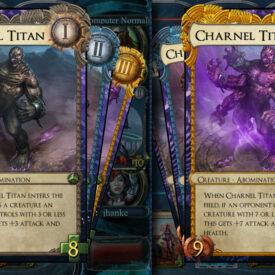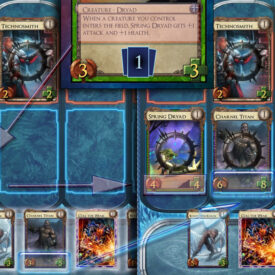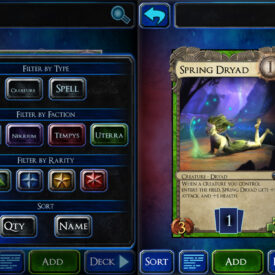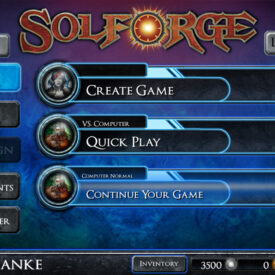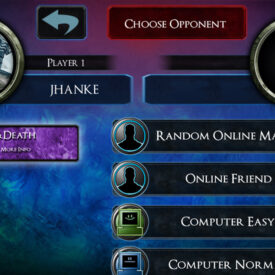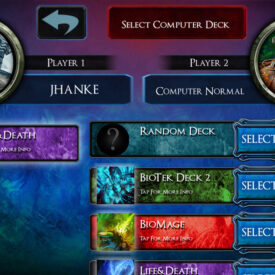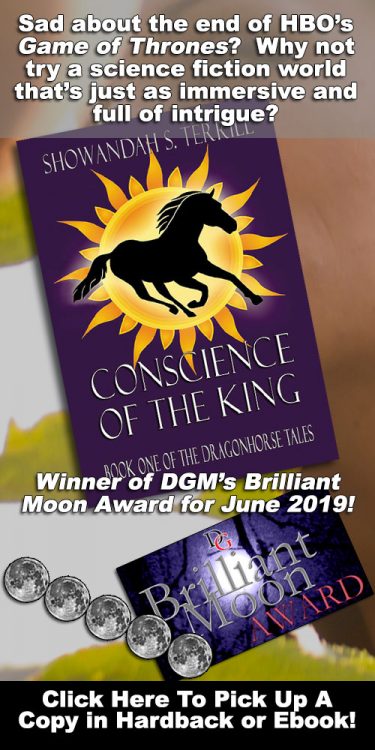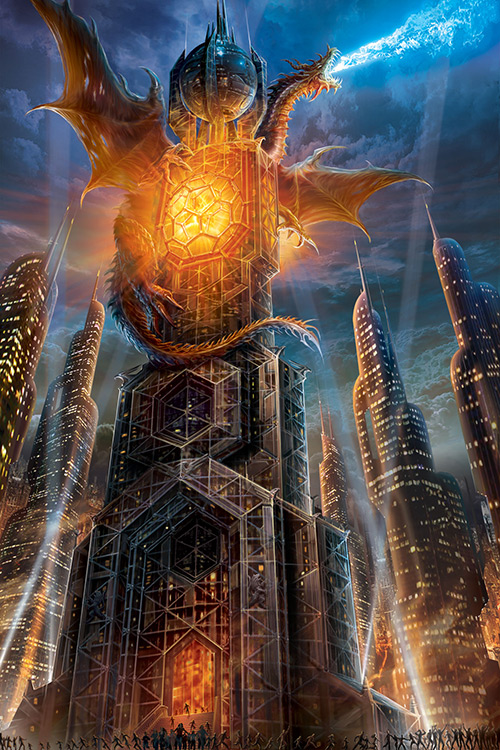 Developer: Stoneblade Entertainment
Developer: Stoneblade Entertainment
Distributor: Stoneblade Entertainment
Genre: Sci-Fi/Fantasty Card Collecting Game
Unique Elements: Card-based strategy game where cards level up within the game.
Series: Standalone
Systems: iOS (iPad 2 or newer; iPhone 4 or newer); PC (via Steam) in Beta; Droid in Beta
Release Date: Available Now
Estimated Length: Unlimited
MSRP: Free-to-play; Premium In-App Currency Available
Website: Developer Site
Download: iOS | PC
Reviewed by: JT Hanke
Final Score: 4.5 Moons (out of 5)
SolForge is an amazing digital card collecting game springing from the collaboration of StoneBlade Entertainment–formerly Gary Games, the creators of the Ascension Deck Building Game–and Richard Garfield–the original designer of Magic the Gathering (MtG) –that was funded in 2012 through an extremely successful Kickstarter campaign .

(This is really a perfect example of the power of crowdfunding models like Kickstarter, which empower fans of a type of game to enable that game’s creation outside of the major publication houses. )
Presentation
The gorgeous artwork and dynamic look of the cards in SolForge help present a world of clashing powers in the form of four rival factions: Alloyin, Nekrium, Tempys, Uterra.
Alloyin is a future tech culture that is most analogous to the White faction in MtG, Nekrium is a death-and-zombie based culture most similar to the Black faction in MtG, Tempys is a magic based culture most similar to a mixture of the Red & Blue factions in MtG, while Uterra is a nature and healing culture most similar to the Green faction of MtG.
While story has never been a huge component of most card based games, games like Magic the Gathering at least have managed to include flavor text on most cards to give you a feel for the world the characters are in. This isn’t really present in SolForge currently.
While the solution to more story could be to add flavor text to the cards, I’m inclined to think that will clutter the card in order to replicate a less than effective system. Instead, I’d love to see them continue to harness the digital power to create either a cinematic or a mini-graphic novel for each of the four cultures. (According to their website, their looking at a “Campaign” mode which would give more of a story-based game option which could also permit co-op battles, which I think would be great.)
Gameplay
The overall card collecting mechanic is similar to MtG, with players starting with a base deck and then the cards of those decks are swapped out with better, more powerful cards that are acquired through booster packs (which are purchased with in-game silver, gold, or as rewards) or through rewarded single player cards.
Unlike MtG, which requires users to gain manna to play cards, SolForge is able to dispense entirely with the need for energy mechanics by simply putting a two card per turn limit. (With the exception being cards that have the word “Free” on them which are usually upgraded cards that can be played without counting toward your two card maximum.)
Each person’s hand consists of five cards and these cards are played across a gameboard consisting of five lanes, which limits moves by players intelligently and ensures the game translates to both tablet and smartphone (currently iOS only, but droid is in beta at the time of this writing). Both players start with 100 health and battle until one of them reaches 0.
What makes SolForge really unique is that each card “levels up” as it is played on the game board, so that future versions of that card are more powerful and deadly. (Somewhat similar to the Evolve ability in MtG, the leveled up creatures in SolForge differ in that they can actually have different abilities, as well as more powerful stats.) This is a great way to utilize the strength of multimedia to give a seamless game mechanic that would be too cumbersome for a physical card game. It augments your strategy tremendously, as you must think of your cards not only in terms of where they are now, but where they will be when they are upgraded. (For example, some cards that are almost throwaway in their initial stages are extremely powerful in their later stages, so you often want to get their weaker versions on the board quickly just to get their upgrades shuffled in as soon as possible.)
To make sure this mechanic has as much effect as possible (and to prevent bogging down of online play by too much pondering by players), after every turn, the three cards not played are put into your discard pile along with the upgraded version of the cards you did play. Every four rounds, your player “levels up” and the discard pile is shuffled back into your play deck. Decks are also restricted to just 30 cards, rather than the minimum of 60 that MtG has, which assures that your leveled up versions are available much sooner..
This free to play game gives some nice rewards to players who want to play without dropping cash, as you can earn silver (the non-premium game currency), cards, and tickets toward tournaments by logging in each day and winning: your first match of the day, your first online match of the day, and your third match of the day.
If you go to the SolForge website, you can find a list of numerous improvements that are on the list for the future. While a lot of these improvements could be really cool, ones that would only appeal to die-hard players like buying customized cards were nested near ones that are highly important to the game’s continued adoption by new players like having some sort of ranking system for online play. While there are a bunch of new features they have in the pipeline that I can’t wait to test out like the ability to Forge new cards from excess cards a player doesn’t need or an online auction house to finally trade excess cards. I know how easy it can be to get so caught up in the flash and bang of a creative project that the things that will actually improve adoption and improve the experience for the long haul might get overlooked.
As such, I wanted to list what I think are the top six improvements that would not only help the game, but actually create more new users that would stay with the system long-term. Since the game is so new in its life cycle (having gone from iPad beta last December to full iOS release, PC beta, and Android beta today), it’s at a really perfect time to focus on some of these things before additions that could make these things more complicated or even impossible down the road are implemented:
- User Selected Ranked Online play Outside of tournaments, there is currently only random match up mode. Nothing is more discouraging or likely to get a new user to stop playing than having to play against a pimp-decked veteran, so having the ability to choose to play against people with a comparable number of games and a similar win-loss record is really important. (Update: According to the developers, there is a hidden algorithm matching people up behind the scenes. However, because you have no control over it, you have no say in what it selects.) Games like the highly popular Zombie survival game, Please Stay Calm, allow you to see the ranks of the different players you wish to Duel so you can choose someone who’s likely less of a challenge, for a lower experience ranking, or a go for broke tackling much harder and experienced opponents for a big experience boost.Letting the user choose his own level of involvement is crucial, especially if rankings are based on multiple parameters–such as: number of games played, number of wins, percentage of rare cards, percentage of Heroic cards, etc–is crucial, I believe. The ratio of high rarity cards would likely be higher in people who either have been very lucky in their acquisitions or have purchased a lot of cards, so they should be in a more elite ranking. (Perhaps these more elite fields could eventually have “pinks battle” as in “racing for pinks” where each side puts up a super-valuable card that the opposing player will permanently acquire if they are victorious over his/her rival.)
- “Earn Gold” & “Earn Event Ticket” options – While freemium games are there to make money for the developer, often through the purchase of premium options, the savviest developers permit those with more time than money to earn in-game premium currency by participating with advertising services like TapJoy (which already offer turnkey options) and watching video trailers, downloading free or low-cost apps, and the like. The revenue generated by these services can provide monetary income to the developer in trade for the premium game features users would unlock in this manner. This type of option is very attractive to college students and other groups that are often low on funds but have the free time to drop in regularly, as well as tending to have access to wi-fi. (College students’ odd hours mean more time that people are available for online play for folks who are looking to game after third shift jobs and the like.)
- “Frequent User” Ticket Rewards – Right now, all rewards (outside of tournaments) are totally random, including event tickets which are necessary to get into tournaments. To test this out, I created two login accounts and played with them both over the course of a week. One account was played with more often, while the other less. Because it’s solely random, the account I played with less actually accrued four tickets over the course of a week, while the account I played with twice as much received only one. (Tournaments cost between 3 to 7 tickets, so, for low- or no-money users, having no way to guarantee getting tickets other than to buy them is likely to be discouraging. Once a player gets into a tournament, further tickets are common rewards if you can win a game or two, but, again, you have no control over who you fight–and getting a person into an event so they can see that they’re enjoyable in the first place is crucial.)Further, non-tournament rewards are limited to the four I mentioned earlier: Daily Checkin, First Win of the day, Third Win, and First Online Win of the Day. Any play beyond that doesn’t count toward future rewards. A “Frequent User” reward system for tickets, at the very least, would be a very good idea–sort of like a frequent user card at a coffee shop, where every sixth or tenth game earns you one event ticket. (Or, to insure there are participants in online mode, perhaps every five completed online matches–regardless of win or loss–unlocks a ticket.) Randomized rewards don’t have to go away, so long as there is a way to at least earn Tickets in a predictable way.
- Daily Tasks – The best example I’ve seen of how this can be used effectively is in the location strategy game I mentioned before, Please Stay Calm, which uses a rotating set of daily tasks which unlock tiered rewards for each task you complete in a 24 hour period. While some of these rewards are about winning battles, many are small things like forging items, scavenging items, or sending a private message to someone. Utilized on top of–not in place of–a daily login reward, these daily tasks actually teach new users about abilities they can use in the game and provide a bit of a scavenger hunt feel to the game.Custom daily tasks for SolForge could include tweaking two of your decks by at least five cards–for those times you don’t have time to play a full game, but could spend a bit of time customizing if you had an incentive–or simply completing online games–regardless of who wins, as there is buy-in to the game itself every time a player completes an online game and, as mentioned earlier, provides competitors for other online players to keep the game fresh. These types of things get people doing different tasks when they’re coming in for their daily checkin and make them more likely to return–rather than taking hiatuses for extended periods of time in between deck expansions. (This becomes even more compelling when simple social interactions like messaging are permitted, as a non-invasive message to another player is something many people will do with an incentive; when card trading is available, for example, players could be tasked to message two people about a card trade.)
- True Offline Mode – In a world in which true unlimited data for cell phones is still not a legitimate reality, a game that uses 3 MB per game to play adds up fast. (Now, the creators originally envisioned a game that could be played more like chess-by-mail, where people could make a move at their convenience and then make another move in the future. This is a good idea for some people, but most people would rather play an entire 15-30 minute game more like speed chess.)Now, unlike most online games, SolForge will let you play games offline (and it has all your specialty deck and card data available), but you don’t have access to your account and all the games you play against the AI when your offline are “just for practice” (so you gain nothing for your win/loss record nor do you accrue any rewards). Since the game already keeps track of your deck and the AI is one that many people will play when they’re not playing online, all that would be needed is a back end counter that keeps track of the games you win offline and a sync option so that you gain rewards for offline play once you log back in. (This would do a lot to encourage use for people in office cubicles or other places where they regularly need to kill small chunks of time and don’t have wifi.)
- System Settings – Some of my favorite cutting edge smartphone/tablet games give you the option to adjust your resolution and effects to allow it to run on older systems; however, SolForge currently does not. It requires pretty modern hardware to be stable; for the iPad, for example, it specifies that it “highly recommends an iPad 2 or faster for stabilityâ€. (With that said, we did test it on an iPad 1 and it will play pretty well, although you can expect approximately 1-2 crashes per game. Fortunately, it does a good job of saving your moves without losing data when it crashes.)It would be nice to have the option to scale down the effects or transitions to make this work on more systems. Considering that the creators already have a beta release on Steam for PC and are nearly to the beta testing for Droid, this seems like a really needed option to give you the largest playable footprint possible.
Gothic Fit
Many of our readers are big role playing and card collecting game enthusiasts, so SolForge should be a natural fit if you’re part of this group. Fans of the darker side of things, will definitely find a lot to enjoy in using the Nekrium in your conquests! (I personally created an amazing deck by combining Uterra and Nekrium cards to create a deck I call The Life & Death deck, which had the ability to poison, create destructive suicide-attacks, and pull off clever resurrection tricks, while also having the power to generate new life, regen life, and buff characters.)
Closing Thoughts
All in all, this is an amazingly great digital card collecting game, which is just out of beta in iOS and still in beta for most of the other options! Hopefully, the ability to fight in weighted online battles and have additional options for earning freemium content will be added in the near future to help ensure an even larger and loyal fan base for something that could be destined to become the ultimate digital card game!
Presentation: 4.0 Moons (out of 5)
Gameplay: 4.5 Moons (out of 5)
Gothic Fit: 5.0 Moons (out of 5)
Final Score (not an average): 4.5 Moons (out of 5)
![]()

